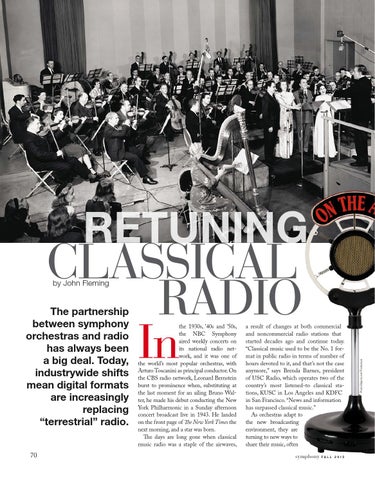RETUNING
CLASSICAL RADIO In
The partnership between symphony orchestras and radio has always been a big deal. Today, industrywide shifts mean digital formats are increasingly replacing “terrestrial” radio. 70
the 1930s, ’40s and ’50s, the NBC Symphony aired weekly concerts on its national radio network, and it was one of the world’s most popular orchestras, with Arturo Toscanini as principal conductor. On the CBS radio network, Leonard Bernstein burst to prominence when, substituting at the last moment for an ailing Bruno Walter, he made his debut conducting the New York Philharmonic in a Sunday afternoon concert broadcast live in 1943. He landed on the front page of The New York Times the next morning, and a star was born. The days are long gone when classical music radio was a staple of the airwaves,
a result of changes at both commercial and noncommercial radio stations that started decades ago and continue today. “Classical music used to be the No. 1 format in public radio in terms of number of hours devoted to it, and that’s not the case anymore,” says Brenda Barnes, president of USC Radio, which operates two of the country’s most listened-to classical stations, KUSC in Los Angeles and KDFC in San Francisco. “News and information has surpassed classical music.” As orchestras adapt to the new broadcasting environment, they are turning to new ways to share their music, often symphony
FALL 2015
PhotoObjects.net/Thinkstock
by John Fleming
